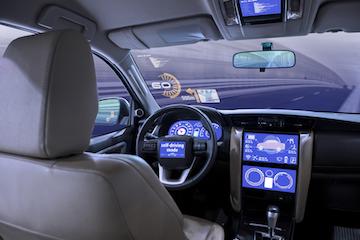Car Makers Drive Hard Towards AI Advances
One of the most visible applications of AI and machine learning in the area of connected cars. Here's how data and analytics are driving these advances.

Today's cars are all about mobility -- not just the kind that transports people and things, but also data mobility. Today's cars are more connected, and they are generating a lot more data that car manufacturers are working to collect, process, and apply to AI developments.
When the average person thinks about the connected car -- whether it is fully automated or packed with sensors that alert the driver to possible dangers -- what comes to mind is the experience for the person in that driver's seat. In fact, the information the driver sees represents only a tiny fraction of all the data collected through the sensor system. The amount of data collected is indeed vast, and car makers are now working on ways to ingest and process it effectively.
Ford just reported that $200 million of its planned $1.2 billion investment in three Michigan manufacturing facilities is earmarked for "an advanced data center to support the company's expansion to an auto and a mobility company." The company already has one in operation. It is building the second in anticipation of "its data usage to increase 1,000 percent -- driven by manufacturing and business needs and new mobility services, such as more connected, autonomous and electrified vehicles."
Separately, Toyota has announced that it is partnering with the NTT Group to jointly tackle driving issues such as preventing accidents and managing traffic by leveraging big data. The goal is to achieve "a sustainable Smart Mobility Society in the future."
The path toward that future may begin as early as 2018. That's the year slated for Toyota's field trial "to assess the feasibility and usability of representative services in the connected car field."
To get to that point, it will be working with NTT on four areas of collaboration:
Platform for data collection, accumulation, and analysis
IoT networks and data centers
Next-generation communication technologies (5G, edge computing)
Agents
The last category is one that draws on AI through a system that makes sense of the data both within and outside the car. Its application is what enables motorists to experience "user-friendly services," including hands-free activation technology.
Toyota is also applying AI within the context of developing next-generation energy that reduces emissions. The company's Research Institute (TRI) plans to spend about $35 million over the next four years on research in collaboration with universities and other research organizations. They include Stanford University, the Massachusetts Institute of Technology, the University of Michigan, the University at Buffalo, the University of Connecticut, and Ilika, a materials science company based in the UK.
TRI Chief Science Officer Eric Krotkov, declared, "Toyota recognizes that artificial intelligence is a vital basic technology that can be leveraged across a range of industries, and we are proud to use it to expand the boundaries of materials science."
In applying AI to material discovery and development, TRI and its partners plan not just to develop pioneering "models and materials for batteries and fuel cells" but to come up with whole new approaches to the application "of machine learning, artificial intelligence, and materials informatics" to accelerate progress. The plan is to innovate "automated materials discovery systems that integrate simulation, machine learning, artificial intelligence, and/or robotics."
Though TRI is a distinct entity owned by Toyota, its research goals dovetail with those of the car company's collaboration with NTT. TRI's founding principles include a commitment to apply automated technologies to improving safety and enabling people who are incapable of driving under existing conditions to enjoy mobility. While mobility in that context means transportation of people, it is helped along by mobile data. It is on that basis that analytics and AI can be used to identify new possibilities.
Read more about:
2017About the Author(s)
You May Also Like
How to Amplify DevOps with DevSecOps
May 22, 2024Generative AI: Use Cases and Risks in 2024
May 29, 2024Smart Service Management
June 4, 2024







